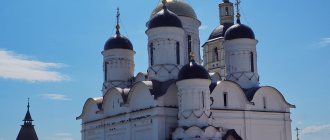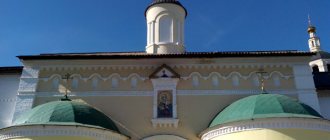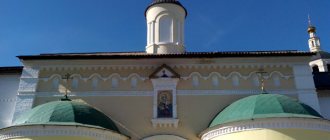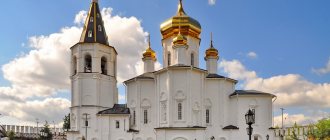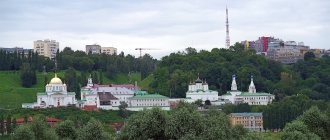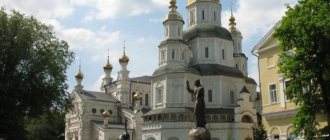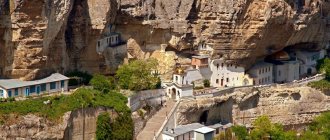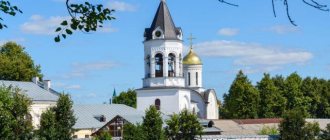History of the foundation of the monastery
At the end of the 14th century, a son was born into a family of pious Christians from the town of Kudinovo, a few kilometers from the city of Borovsk, who was named Parthenius. Legend has it that the boy’s grandfather was a Tatar tax collector who converted to Orthodoxy. At the age of 12, the son left his parents’ home and settled in the Intercession Monastery, located nearby.
St. Pafnutiev Borovsky Monastery in the Kaluga region
At the age of 19, Parthenius took monastic vows from Abbot Markel and received the monastic name Paphnutius.
- In 1434 he was elected hegumen of the Intercession Hermitage, the ordination ritual was led by Metropolitan Photius. After 10 years, Paphnutius suffers from a serious illness, so he accepts the great schema, leaves the desert and settles on the banks of a river called Protva and founds the Borovsk monastery.
- Four years later, in the new desert, the construction of the wooden Cathedral of the Nativity of the Virgin Mary is completed. In 1467, another church, built on the basis of stone, was erected in its place. After 10 years, the walls of this temple were painted with frescoes; the work was done by famous icon painters and their sons.
- In 1477, the founder of the monastery humbly retired to the Heavenly monastery; Abbot Joseph was elected as the new abbot, who after a short period of time left the desert and settled in the Volokolamsk lands.
- In 1480, Prince John III visited the Borovsk monastery, who was actively fighting against the Mongol troops. The ruler highly appreciated the painting of the walls of the main temple and invited the masters who worked here to the capital.
- At the beginning of the 16th century, construction of the Church of the Nativity of the Savior began in the desert. In 1529, Prince Vasily the Third visited the monastery; he prayed for an heir to the throne.
- In 1531, a council of clergy established a celebration in honor of the death of the founder Paphnutius - May 1 (old style). After 14 years, the venerable schema-monk was canonized as a holy wonderworker.
- In 1584, a decision was made to dismantle the stone Cathedral of the Nativity of Our Lady in order to enlarge the building. Tsar Fedor gave instructions for the construction of a new brick temple, the work was supervised by B. Godunov.
Events from the 17th century
In 1610, the army of False Dmitry II, aiming to conquer Moscow, invaded the walls of the Borovsky Monastery. The enemies were merciless to the brethren and peasants from nearby settlements; they plundered shrines and burned church buildings. After 20 years, Patriarch Filaret visited the monastery, and the necessary funds were allocated to restore the monastery complex.
- In the period from 1620 to 1640, a temple was built here in honor of the venerable founder Paphnutius, and the walls of the Church of the Nativity of the Most Pure Mother of God were painted.
Cathedral of the Nativity of the Virgin Mary in the Pafnutiev-Borovsky Monastery - In 1670, a cathedral was erected on the territory of the Borovsk monastery, consecrated in honor of Elijah the Prophet, and hospital wards were included in the structure of the building. At the end of the 16th century. the monastery pragmatically replaced the hipped belfry with a high bell tower.
- In 1760, the monastery complex was replenished with a cathedral, consecrated in honor of the Monk Mitrofan of Tsaregrad. After 16 years, a seminary was solemnly opened here, where children from Orthodox families were taught Russian and Latin letters.
- In 1812, the Borovskaya Hermitage again suffered from the penetration of enemy troops. Napoleon's army entered these sacred walls, burned several fraternal cells and plundered the shrines. After 10 years, the monastery was restored and updated.
- In 1828, the Holy Synod established a solemn procession in honor of St. Paphnutius. The move, scheduled for May 1 (the day of the saint's repose), began from the city of Borovsk and ended within the walls of the monastery. In 1837, the dilapidated porch (outer porch) of the Cathedral of the Nativity of Our Lady was replaced with a brick refectory.
Deserts in the 20th century and in our time
In 1919, a special Moscow commission carried out a thorough inspection of the monastic complex and officially established its historical value, and also made an inventory of all monastic property. After 3 years, relics were confiscated here to help starving people in the Volga region. In May 1922
Interior decoration of the Cathedral of the Pafnutiev-Borovsky Monastery
The Borovsk monastery was closed and given the status of a historical museum. Soon the monastery farm was turned into an agricultural commune, but it was liquidated a year later. Enterprises of various types were located on the territory.
- In 1935, a mechanization school was organized here, and an educational building was built on the site of the necropolis and the Church of All Saints. In 1941, the territory was captured by German occupiers, who left the monastery a year later, having lost the battle to Soviet troops.
- The school of mechanization begins its activities again, but at the end of the war it is reorganized into a gymnasium for production instructors. In 1953, various educational buildings, oil depots and workshops were created on the territory of the monastery.
- In 1954, the main dome of the Cathedral of the Nativity of the Blessed Virgin Mary collapsed. A year later, research begins on the restoration of the monastery complex. In 1968, historical and local history museums were created here.
- In 1990, an official decision was made to transfer the Pafnuteva Hermitage to the management of the Kaluga diocese. Monastic life is revived, the first monks arrive, and the Church of Elijah the Prophet is solemnly consecrated.
- In 1992, the technical school of mechanization was removed from the walls of the desert, and a year later the day of remembrance of St. Paphnutius was solemnly celebrated. In 1995, the monastery was enriched with holy images and church relics.
On a note! Since the transfer of the Borovsk Hermitage to the management of the Russian Orthodox Church and the resumption of monastic hostelry here, painstaking and serious restoration work began. Today, most of the work has come to an end; pilgrims visiting the monastery note its amenities and indescribable grace of architecture.
Father Seraphim
When they tell me that only old women go to our Church, I remember how in the 2000s, when I was the editor of the Orthodox youth newspaper “Pokrov” in Yekaterinburg, a professor from one of the oldest English universities, the University of Sussex, Professor Stella Rock, came to see me. A professional historian specially came to Russia to study Christian youth movements. In her opinion, this is a Russian phenomenon of a new youth culture, capable of returning Christian roots to an entire generation that opposes globalization, the culture of consumerism and selfishness of the Pepsi generation. We went with her to youth clubs at churches, were in university Orthodox fraternities and Orthodox hand-to-hand combat clubs. And everywhere we were met by modern, educated, successful young people. They studied, some had their own business, some were engaged in science, some worked. Unlike their peers, they were not interested in nightclubs, money and wasting their lives, but in life with God and the future of their country, from where they had no intention of leaving...
The rector of the Pafnutiev Borovsky Monastery, Archimandrite Seraphim (Savostyanov), is also from this generation. He is forty-three, he graduated from the Moscow Theological Seminary, the Kyiv Theological Academy, and is studying for a master's degree at the Kaluga State Institute at the Faculty of Legal Psychology. Chairman of the Commission for Religious Education and Catechesis of the Kaluga Metropolis; member of the Coordination Council under the Governor of the Kaluga Region for the development and implementation of the regional Strategy in the interests of children; author of theological works and articles on spiritual and moral topics.
The abbot of one of the oldest monasteries in Russia was born in the small Ural town of Serov into a family of workers. When most of his peers went to earn money, he got a job as an altar boy in the Church of the Prophet Elijah. I then studied at Tyumen State University and remember those times well. The beginning of the nineties, the time of crimson jackets, vouchers and the plunder of a great country. Freedom hit Russia like a tsunami, moral laws ended up in a landfill along with Soviet ideology. The new morality said: Homo homini lupus est. Man is a wolf, and happiness is in money! Earn by any means, take as much as you can, do what you want, because today we live, and tomorrow we die! Drugs were sold on the porch of the main building of our University, and people were shot right on the streets. My friend, the future head coach of the Russian adult karate team, Georgy Khizhnyakov, and I guarded our elder Pasha when he went to get a scholarship for the group, so that he would not be robbed on the way. And across the road from Tyumen University there was the Znamensky Cathedral and I have never seen so many people at services as in those hard times.
In troubled times, in times of testing, many people began to go to churches. When there is darkness around, some learn to live in darkness, while others go to Church. My friend, who graduated from the Law Academy with honors, went to Valaam and became a monk. And the future abbot of the Pafnutiev Monastery entered the first year of the Moscow Theological Seminary. A year later, in the Church of the Korsun Icon of the Mother of God of the St. Nicholas Chernoostrovsky Monastery, Metropolitan Clement of Kaluga and Borovsk, he was tonsured into monasticism with the name Seraphim, in memory of the Venerable Seraphim of Sarov. Since 1994, Father Seraphim taught liturgics, Church history and moral theology at the Kaluga Theological Seminary. For almost ten years he was in charge of the office of the Kaluga diocesan administration. On October 15, 1999, the bishop gave him a new obedience - he was appointed abbot of the St. Pafnutev Borovsky Monastery.
Father Seraphim was twenty-eight years old, and he was the governor of an ancient monastery. From a worldly point of view, it is a spectacular career for a successful young man. On the spiritual side - a cross from God and new trials. To continue the work of a great saint of God is a huge responsibility. The monastery is Heaven on earth, where completely different laws reign than outside its ancient walls.
Here is what Basil the Great wrote about the monasteries: “I praise the perfect life of the monasteries, which have expelled their property, freed from all disagreement, all confusion, trampling on stubbornness and disputes; there is everything in common, souls, opinions, bodies, and with this their bodies are cherished and nourished; common God, common piety, common salvation, common deeds, common illnesses, common crowns, one in all and one not alone, but all. What can be compared with this life, what could be more blessed than it? One is the other’s servant, one is the other’s master, their love is free from the subordination of one to the other.”
To bring these beautiful, sublime words to life, a lot of work, sweat and blood is needed. Father Seraphim recalled how difficult it was to restore the monastery. There was endless construction all around, there was a shortage of basic necessities, and we had to pay huge amounts of money for electricity. But there was no money. And there was absolutely nowhere to take them. The father-vicar went to the authorities and asked for benefactors, but all in vain. And on the last day, when the lights were to be turned off in the monastery, and restoration work would have stopped, and the electric ovens of the bakery and kitchen would have gone out, he went to the Monk Paphnutius, fell on his knees in front of his holy shrine and simply cried. And when he left the temple, some woman caught up with him, put an envelope in his hands and disappeared into the crowd. When the abbot opened the envelope, there was money there. Exactly as much as you had to pay for electricity.
The Monk Paphnutius always strengthened, instructed and sent assistance to the young abbot in his ministry. Fulfilling the monk’s behest of hospitality, who during the famine years fed up to a thousand people a day in the monastery refectory, Father Seraphim opened a “People’s Dinner” packaging workshop in the monastery, where he, together with the youth squad of the monastery, packages the food. Because a monk is not one who speaks, he is one who does. And there is no better way to teach than to show by personal example.
Of course, Father Seraphim is helped in many ways by the monastery’s confessor, Father Vlasiy. Without it, the Borovsky Monastery is also impossible to imagine, like a temple without people. Everything seems to be beautiful, but the main thing is missing. He is the continuator of the spiritual work of St. Paphnutius and a living testimony to the Paschal joy of our faith. But as the priest himself said: what’s the point if I pray for you and you don’t do anything?
The Borovsky abbot sanctifies sports clubs, writes articles and speaks at conferences. Congratulates veterans and holds meetings with heads of municipal associations. Perhaps this is why the Fundamentals of Orthodox culture in schools in the Borovsky district have become an integral part of the educational program of the vast majority of schools, on which several generations have already grown up. Schoolchildren, cadets and soldiers of nearby military units are always guests of the monastery, and pilgrims come here all year round from all over the world. Even American Indians came. So what? Moreover, these are not just any Indians, but Indians from Fort Ross in Alaska, the homeland of Russian colonists.
Today it seems incredible, but fifteen years ago few people knew about the Pafnutiev Borovsky Monastery. And now, for example, the head of the Russian Orthodox Church Outside of Russia, Metropolitan Hilarion, begins his pilgrimage trip across Russia from the Borovsk monastery. A section of the All-Russian forum “Children! Russia! Future!”, where the Commissioner of the President of Russia for Children’s Rights Pavel Astakhov spoke and “Moscow Virtuosi” came. But the main thing, of course, is not this. The main decoration of the monastery and its treasure are the brethren, the monks. And in the monastery alone over the last year there have been several more people. And this despite the fact that Father Seraphim is a strict abbot, and does not just hand out cassocks. You need to work hard and humble yourself in order to be accepted into the army of Christ.
When the father-vicar and father-confessor, Schema-Archimandrite Blasius, were chosen as honorary citizens of Borovsk, receiving the award, Father Seraphim said: “Now they give me flowers and congratulate me, as if these were my merits. But this is the merit of the people of our monastery. They worked, they tried, and here I am, it turns out, collecting the cream. The high award that you have awarded me is recognition of the work of our entire monastery: the brethren, the workers and everyone who helps us. Thank you all, dear brothers in Christ and co-workers, for your conscientious and selfless work for the good of our monastery!”
And it is difficult to find better words about the place of the Orthodox vicar in the life of the monastery and his attitude towards life.
The rules of life of Father Seraphim (from interviews and speeches):
When fifteen years ago I was appointed to the monastery, congratulations came from everywhere: “Congratulations to you, such a high position in the Church!” - and only one person said to me: “I sympathize.” Time has shown that he was right.
An acquaintance of mine told me that when I was at school, the history teacher told them that only the Church is the custodian of faith, traditions and the Russian language. This is what a history teacher told his students in a Soviet school. He said it in such a way that the words sank into the soul of the boy, who remembered them for the rest of his life. This is what it means to be a teacher.
When people ask me about significant events, I say that the very revival of monastic life in the monastery is already a significant event. For 70 years they tried to destroy the Church, but the Church survived. And the fact that we are now reviving the monasteries, restoring normal monastic life there - these are significant events. Look how many people come to monasteries! And young and old, and with children and alone. Faith is the most important thing for a person. A believer is a significant event, this is important. The fact that the Church is blossoming is the most significant event for me.
to our monastery for Easter . And among them there was one gypsy boy. His grandfather takes him from the Zhukovsky district to this particular school, where Orthodoxy is taught and no one forces this child. He wanted it that way himself. Live with Christ. Do you understand what a complex people they are? They have their own specific culture, everything is their own. And this boy says: I want to be Orthodox! Isn't this a miracle?
The Holy Fathers also told us: “If they tell you that everything is good and calm in the monastery, then they are either lying or the monastery is not true.”
At first, the monastery's relationship with the authorities was very difficult. But gradually - the Lord does not give everything to a person right away, everything has changed. As John Chrysostom says: “The Lord does not immediately work miracles in a person’s life.” It leads to a certain point when a person no longer sees a way out of the current situation, and when a person resorts to some purely human solutions to the problems that arise for him, when he no longer sees a way out - that’s it, all human resources have already been tried - nothing It doesn’t help when a person turns to God, that’s when the Lord begins to work miracles. Having tried all human factors, I turned to God and, as a result, we now have excellent relations with both the district leadership and the city leadership, and many joint projects and events.
15 years ago, when I was appointed abbot, it was an amazing discovery for me that they did not know about the Borovsky Monastery.
The revival of the monastery began when, on December 29, 1990, the executive committee of the Kaluga region granted the petition of Metropolitan (then Archbishop) of Kaluga and Borovsk Clement for the return of the Nativity of the Virgin Mary to the St. Paphnutiev Borovsky Monastery of the Kaluga Diocese of the Russian Orthodox Church. From the first days of the restoration of the monastery, paramount importance was attached to the spiritual life of the brethren and the daily routine. This is the secret of the flourishing of the monastery of St. Paphnutius.
Monastic life and enlightenment were inseparable concepts, since ancient Russian monasteries were centers of education and writing, centers of art and architectural monuments. Here books were translated into Russian, original literary works (and not only spiritual ones), and chronicles were created.
Book printing in Rus' began thanks to church enlightenment. After all, the first books of the first printer, Deacon John Fedorov (who, by the way, belonged to the entourage of St. Macarius, who also labored in the Kaluga land) were the liturgical “Apostle”, “Gospel” and “Psalter”.
When, back in the tenth century , under Prince Vladimir, we adopted Christianity, we did not just accept some other religion, another faith. We have adopted a different law of communication between man and God, communication between man and man, built on the principles of love and forgiveness. We have become Russians, as the whole world knows us today.
The Gospel gives a person the main thing - a goal in life, and the means to achieve it. The goal is unity with the Incarnate God, our Savior Jesus Christ, the good news of Whom the Gospel proclaims to us.
In principle, it is wrong to separate spiritual wisdom from everyday life, because a person lives a spiritual life only when he puts it into practice, and not when he accumulates certain information on this issue in his memory.
The Sermon on the Mount is the foundation laid down in the great Russian culture, without which it ceases to be both Russian and culture, examples of which, unfortunately, are before our eyes.
There were never easy times. It was difficult then, and it is difficult now. When there are no difficulties, development will stop and stagnation will begin.
25 years of the revival of the Russian Orthodox Church can be compared with half of the forty years of the Jews walking in the desert. Although we have crossed the line of twenty years, it is difficult for our society, which was brought up in a completely different ideology for 70 years, to change.
In his farewell conversation, the Lord said to the disciples: “Love one another, just as I have loved you, so love one another. By this everyone will know that you are My disciples, if you have love for one another” (John 13:34). And it is on such sacrificial holy love, giving itself up to death on the Cross for all of us, that all of Christianity is based.
Culture everywhere and always has been an expression of the life of a people, an expression of its existence. First of all, it determines a person’s daily way of life, determines his spiritual world and his system of values.
A return to the spiritual sources of national culture, their preservation and development is an indispensable condition for the survival of any nation and any state. Attempts to replace them are always doomed to failure and directly lead to the degradation of society.
In our region, the subject “Fundamentals of Orthodox Culture” has been taught since the mid-90s. The quality may not have been the same then as it is now, but we had it. And when we spoke, for example, five years ago, inviting other districts to cooperate to help them organize Readings or hold a conference, they said: “Sorry, but we don’t have such experience. You have this, but we don’t have this experience.” For this experience of teaching “Fundamentals of Orthodox Culture” people come to us not only from other regions, they come from completely remote areas, from Siberia, in general, people come from very far away.
The value of tradition lies in the fact that it represents the positive experience of a people, selected over the centuries, acquired as a result of overcoming various problems and difficulties, which, it is important to note, are characteristic of this particular people, and not of some abstract humanity, whose name and interests are often various ideologies of the modern world are covered up.
Today the Kaluga region is an economically stable and successfully developing region. But not everyone associates material success with the spirituality of the people living here, as well as with the cultural norm of church-state relations that ensures the economic prosperity of the region.
It is good, of course, that in our country new churches and monasteries are being revived and built. However, the main thing is not to close yourself within these walls so that this does not become a goal. The walls will remain the same as walls. The revival of Holy Rus' is, first of all, the revival of the human soul.
During the cross flight on MI-8
Architecture
The territory of the St. Paphnutiev monastery complex is well-groomed; pilgrims and residents are inspired by the surroundings of colorful flowers, tranquil greenery and mighty, calm trees. The desert is surrounded by a fortress wall with several towers, each of which is given an individual name; behind this fence a river flows and there is a small pond.
Gate fresco icon “Oranta” at the entrance to the monastery
- The central building is the church, consecrated in honor of the Nativity of the Most Pure Mother of God. Over the 4 centuries of its existence, the cathedral was remodeled several times. The interior decoration is painted in the Byzantine style. In the wall on the north side there is a secret room where there is a room for storing monastic money and other valuables.
- In 1670, the first stone of a one-story small church in honor of Elijah the Prophet was laid at the monastery. Heavy brick was used as a building material. The building is adjacent to two vestibules, which were previously used as a hospital and a refectory. In memory of the tragic events of the Time of Troubles, a worship cross was erected nearby.
- The church in honor of St. Mitrofan was built in the middle of the 18th century; it is considered one of the latest buildings on the territory of the Pafnutiev Monastery. The temple stands on a high foundation, has one floor and a dome. In the basement (lower tier) there are two chambers. In 1992, the cathedral was consecrated, and the miraculous remains of the great martyrs of the Chozevites were placed on the altar.
- Attached to the refectory is a high bell tower, which is an independent building. Its height from the base to the tip of the cross is 55 meters. Since ancient times, on the first tier there was a staircase leading to the cathedral and the external extension. On the second floor of the bell tower there was a library and a sacristy, and on the third there was a clock with a bell mechanism. The upper tiers were originally intended for ringing, which was amplified by hollow vessels in the wall.
- In the 17th century, a three-story building was erected, which was called the Archimandrite’s Chambers. The building was rebuilt many times and today resembles a barracks from Nicholas times. On the first tier there are cells for guests, on the second - the abbot's chambers, above - the fraternal chambers.
Father Vlasiy from Borovsky Monastery
As mentioned earlier, Vlasiy had a difficult fate; he was forced to leave medical university because of his sincere love for God and the desire to develop in the field of religion. His own grandmother instilled this love in him. Despite all the difficulties, when he began to do what he loved, he felt a strong flow of vital energy, strength and vigor.
The best article for you, go to: What does a servant of God mean in Orthodoxy
For several years he was forced to hide from law enforcement agencies because he was considered a persistent violator of the law. Slowly, life began to get better and a misfortune happened: robbers attacked the monastery, beat him so much that the doctors fought for his life for a very long time, but nevertheless their efforts were appreciated and gave a positive result.
After some time, he underwent several more operations and was forced to leave Russia. Without stopping for a minute to pray and believe in the Almighty, he was very far from home for 6 long years. His prayers were heard, and the illness subsided, he was completely healed and was able to return with peace of mind to the Pafnutiev-Borovsky Monastery , where he still serves.
His positivity, vital energy, strength and cheerfulness are enough for everyone, he never complains, but humbly accepts everything that the Almighty gives him. Once, looking at a complete stranger to him, he can say with accuracy what is bothering him and give him wise advice on how to live further.
The main thing is to listen to his words and believe that everything will definitely be fine; life’s difficulties are given in order to constantly fight and gain invaluable experience. Many people wonder how to get to Father Vlasiy, what days does he receive?
- You can get to him by calling the monastery in advance and making an appointment.
- It is open every day (with the exception of religious holidays) from 04:00 to 21:00.
- If you need to confess, come early before the church opens to get in line.
The best article for you, go to: Prophecies of Orthodox Elders
